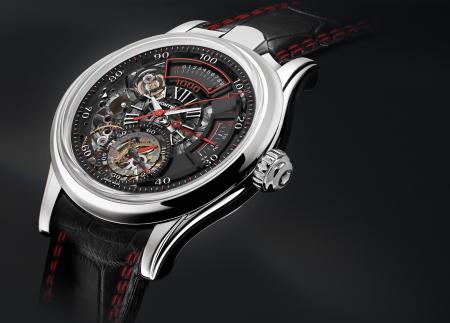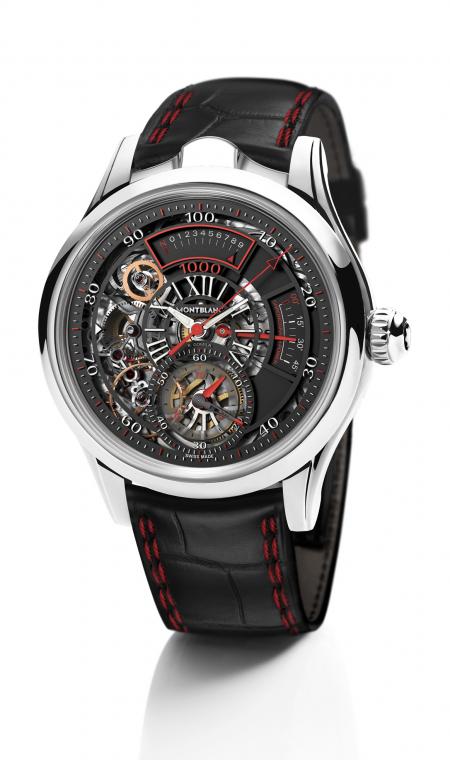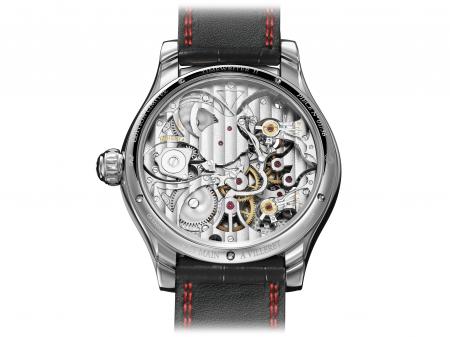Novelty SIHH 2012 – Montblanc
By MyWatch
The Chronographic Paradox: Montblanc’s TimeWriter II Chronographe Bi-Fréquence 1,000
Montblanc’s master watchmakers in Villeret have achieved a remarkable feat with the TimeWriter II Chronographe Bi-Fréquence 1,000. One is tempted to describe it as a triumph of mind over matter when this fifty-hertz chronograph is halted after measuring an elapsed interval and shows the span’s duration with 1/1,000th-of-a-second precision at first glance. This watch was created in the context of the TimeWriter concept, which inspires the “Fondation Minerva” (that Montblanc founded in 2008) to create timepieces at two-year intervals which advance the great tradition of the authentic Swiss art of watchmaking towards its even greater future.
Each timepiece constructed in the context of this project is a genuine innovation that embodies an entirely new idea but always transforms that concept into tangible reality through reliance on tradition. Furthermore, each such watch demands both broad-based horological expertise and the highest degree of craftsmanly skill. This was already most beautifully illustrated in 2010 by the Montblanc TimeWriter I Metamorphosis: a chronograph equipped with a filigree mechanism on the dial, activated by a lateral cursor that sets into motion a transformation of the dial from the function and characteristic of a sportily dynamic chronograph to the visage of a classically elegant watch and vice versa.
The TimeWriter project also endeavors to support talented and highly promising watchmakers. In accord with this philosophy, the TimeWriter II was realized by the Hispano-Swiss watchmaker Bartomeu Gomila at Montblanc’s ateliers in Villeret under the aegis of master watchmaker Demetrio Cabiddu.
Born on the Balearic island of Menorca, Bartomeu Gomila completed his training at WOSTEP in the category of “restoration and complicated timepieces” and is the first Spanish citizen to have earned a diploma from this renowned institution of higher learning. Recognized by the Swiss state, WOSTEP (Watchmakers of Switzerland Training and Educational Program) is an independent institution that’s jointly supported by businesses in the Swiss watchmaking industry, international watchmakers’ associations and watch dealerships around the world. As a continuing-education institution, its prospective students must prove that they have completed their training as watchmakers and have gained several years of professional experience in their métier. The widely diverse courses taught at WOSTEP include an introduction to the Swiss lever escapement, precision time measurement, and the functions of watches with “grandes complications”. A certificate from WOSTEP is recognized worldwide as one of the highest educational qualifications for watchmakers. After completing his course of studies, Gomilla restored historical timepieces from renowned brands and most recently worked as a freelance restorer of historical timepieces for international collectors.
A Pioneer in the Measurement of Extremely Brief Intervals
Founded in 1858, the Minerva manufacture was completely integrated into Montblanc as the brand’s haute horlogerie manufacture in 2008. For more than a century, Minerva has ranked among the most famous, limited suppliers of high-quality instruments for measuring brief intervals of time with an outstanding precision. This is true both for watches which combine a display of the ordinary time and a stopwatch function (now generally termed “chronographs”), as well as for classical stopwatches, which serve only to measure brief elapsed intervals. Minerva was among the first to debut a mechanical stopwatch with 1/100th-of-a-second accuracy. This stopwatch, which appeared around 1916 and was redeveloped in 1936, has a large chronograph-hand that completes one full circle every second. Nearly a century later, this timepiece would serve as an inspiration when Montblanc’s watchmakers began the project of realizing the Montblanc TimeWriter II Chronographe Bi-Fréquence 1,000.
A first glance this superlative Montblanc chronograph raises the question: “Where are the chronograph’s buttons?” As an authentic monopusher, this watch has only one button. In homage to the ultrafast stopwatches presented by Minerva in 1936, which were included in the Guinness Book of Records, this lone button is positioned at “12 o’clock” and exactly midway between the horns, where none but chronographic initiates are likely to see it and comprehend its purpose. Beneath this button stretches a dial that promises complicated mechanical timekeeping in its purest form. This multilayered sculpture presents various functions on different levels. This description may sound complex, but the practical result is good and provides unmistakable legibility.
The 1/1,000th of a Second at a Glance
The ordinary time of day or night is indicated by an hour-hand and a minute-hand at the center of the dial; a rotating disc of sapphire crystal collaborates with an immobile triangular index to track the continually running seconds at “9 o’clock”: both of these displays keep time accurately thanks to a large screw balance which swings at the traditional pace of 18,000 hourly semi-oscillations (2.5 Hz) and is readily visible through the partially skeletonized dial at “7 o’clock.”
All other indicators serve the chronograph function, to which this exclusive timepiece devotes the highest priority. The chronograph’s little balance can be seen at “half past ten”: when this speed demon is switched on, it oscillates at a rate of 360,000 A/h (50 Hz). These vibrations are so fast that they can no longer be seen by an unaided eye: only a quiet purr can be heard, not unlike the sound of a well-lubricated Singer sewing machine. The chronograph’s indicators begin with a red, centrally axial, elapsed-seconds hand: it completes one full 360° rotation every second so that its tip sprints along the hundredths-of-a-second scale on the dial’s periphery.
A double counter at “6 o’clock” has a longer, red-tipped hand tip to tally elapsed seconds from one to sixty, as well as shorter, all-red hand to count a maximum of fifteen elapsed minutes. A slightly inset cartouche at “3 o’clock” indicates the remaining reserve of power for the chronograph’s movement which, when fully wound, will suffice for more than forty-five minutes.
The power-reserve display also serves as a helpful indicator for the chronograph because it shows how much longer the chronograph will continue to run beyond the fifteen elapsed minutes it can tally. But the unchallenged pièce de résistance tops the dial at “12 o’clock,” where another cartouche boasts a little triangular arrowhead that runs along an arcing scale calibrated from N (for “neutral”) through zero, and thence to nine-thousandths of a second.


